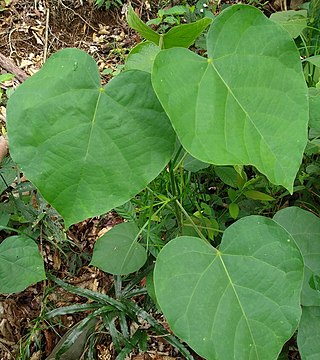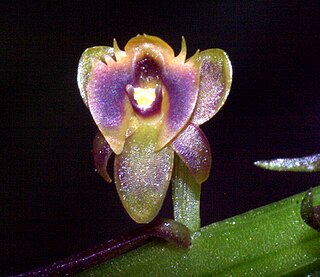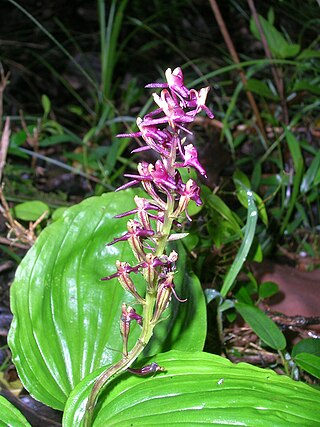
Calamansi, also known as kalamansi, calamondin, Philippine lime, or Philippine lemon, is an economically important citrus hybrid predominantly cultivated in the Philippines. It is native to the Philippines, parts of Indonesia, Malaysia, and Brunei, as well as parts of southern China and Taiwan.

Endospermum is a genus of plants, under the family Euphorbiaceae and the monotypic subtribe Endosperminae first described as a genus in 1861 They are dioecious, rarely monoecious trees. It is native to E + S + SE Asia, Papuasia, Queensland, and certain islands of the W Pacific.

Codiaeum is a genus of plants under the family Euphorbiaceae first described as a genus in 1824. It is native to insular Southeast Asia, northern Australia and Papuasia.

Crepidium, commonly known as 沼兰属 or spur orchids is a genus of about three hundred species of orchids in the family Orchidaceae. Plants in this genus are evergreen, mostly terrestrial plants with short stems lying on the ground, two or more relatively large, pleated leaves and small, non-resupinate flowers with spreading sepals and petals. The genus is widely distributed in the tropics.
Hanna Bogna Margońska, born 1968 is a Polish botanist known for her work on orchids.

Crepidium quadridentatum is a species of plant in the family Orchidaceae, endemic to the Philippines

Crepidium dentatum, the toothed Crepidium, is a species of plant in the family Orchidaceae, endemic to the Philippines.

Crepidium uncatum is a member of the family Orchidaceae, endemic to the Philippines.

Crepidium quadrilobum is a species of plant in the family Orchidaceae, endemic to the Philippines.

Crepidium binabayense is a member of the family Orchidaceae, endemic to the Philippines.

Crepidium tjiwideiense is a species of the family Orchidaceae endemic to the Philippines.

The total primary energy consumption of the Philippines in 2012 was 30.2 Mtoe, most of which came from fossil fuels. Electricity consumption in 2010 was 64.52 TWh, of which almost two-thirds came from fossil fuels, 21% from hydroelectric plants, and 13% from other renewable sources. The total generating capacity was 16.36 GW.

Malaxidinae is an subtribe of orchids in the tribe Malaxideae of the subfamily Epidendroideae.
Crepidium elegans is a species of epidendroid orchids in the tribe Malaxideae.

Crepidium fimbriatum, commonly known as the fringed spur orchid, is a plant in the orchid family and is endemic to tropical Far North Queensland. It is an evergreen, terrestrial orchid with a fleshy stem, wavy leaves and many purple flowers crowded on a purple flowering stem.
Crepidium fontinale, commonly known as the yellow spur orchid, is a plant in the orchid family and is endemic to the Northern Territory. It is an evergreen, terrestrial orchid with a fleshy stem, wavy leaves and many yellowish green flowers crowded on a green flowering stem.

Crepidium lawleri, commonly known as the small spur orchid, is a plant in the orchid family and is endemic to tropical far north Queensland. It is an evergreen, terrestrial orchid with an upright stem, dark green leaves and up to ten greenish cream-coloured flowers well spaced along a brittle flowering stem.

Crepidium marsupichilum, commonly known as the pouched spur orchid, is a plant in the orchid family and is endemic to tropical far north Queensland. It is an evergreen, terrestrial orchid with an cone-shaped stem, light green, shiny leaves and a large number of purple flowers crowded along a green and purple flowering stem.
Epipremnum moluccanum is a species of flowering plant belonging to the genus Epipremnum and the family Araceae.














